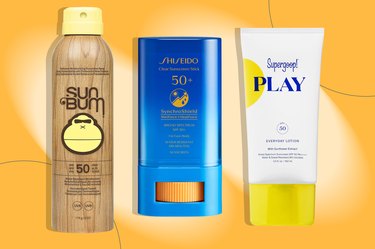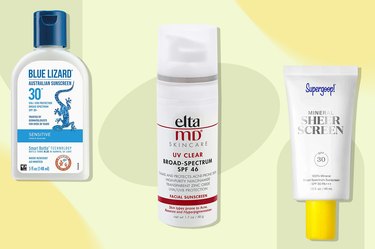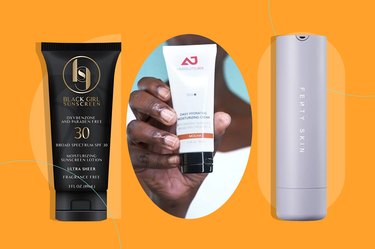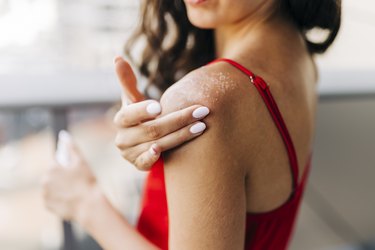
A painful, blistering sunburn is a clear sign your skin is in some distress. But just how concerning are those fluid-filled bumps, and what should you be doing to care for them?
Blisters can be a normal part of the healing process for sunburned skin. The key is keeping the affected area hydrated and avoiding popping or picking.
Video of the Day
Video of the Day
Here's more on what you can do to help your skin feel better, how to avoid blisters in the future and when to call your doctor for a bad sunburn.
What Are Sunburn Blisters?
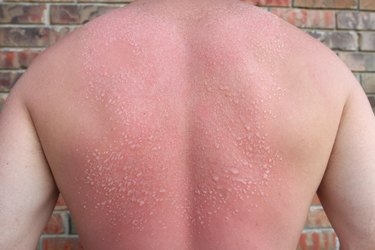
Blisters are bubbles of clear fluid that form under the skin in response to damage caused by friction (like your foot rubbing against the inside of your shoe without a sock) or heat (like a sunburn). It's the body's way of trying to protect the underlying skin from infection.
"In a way, blisters act as a biological bandage," says Emily Wood, MD, a board-certified dermatologist with Westlake Dermatology in Austin, Texas.
Sunburned skin has sustained damage from the sun's UV rays. This damage causes skin to become red, painful and inflamed. (It's not uncommon to experience other symptoms too, like a headache, fatigue, nausea or even a fever.)
After a few hours to a few days, the burned area may start to blister and eventually peel to slough off the damaged skin and help skin heal, according to the Cleveland Clinic.
Even mild sunburns can blister. But more serious sunburns tend to have blisters that are bigger or spread out over a wider area. The skin might appear swollen or even wet-looking too, the Cleveland Clinic notes.
Sunburn Blisters and Sun Poisoning
Sometimes sunburn blisters can be a sign of sun poisoning, a type of heat illness. This is especially true for sunburn blisters on the lips, per the Cleveland Clinic.
Besides blistering or peeling skin, symptoms of sun poisoning include the following:
- Severe rash
- Nausea
- Dizziness
- Confusion
- Lightheadedness
- Shortness of breath
- Fainting
These symptoms don't happen because the sun's rays are poisonous, though. (They're not.) Instead, they're signs of skin trauma and extreme dehydration, the Cleveland Clinic notes.
If you think you or someone you know has heat illness or sun poisoning, start by getting to a cool, shaded place. Try to rest and cool the skin with a damp cloth or a fan. Sip an electrolyte-containing drink like a sports drink to replenish lost fluids, recommends the Centers for Disease Control and Prevention.
Seek medical attention if the symptoms get worse or don't ease up within an hour, and call 911 for potentially life-threatening symptoms such as a high fever, racing pulse or loss of consciousness.
How to Treat Sunburn Blisters
Blisters help protect your skin as it heals from a sunburn, so you shouldn't try to pop or peel them. "The best thing to do is leave them intact, since popping or picking at them could be an entry point for infection," Dr. Wood says.
If a blister pops on its own, wash it gently with soap and water and cover the area with a nonstick bandage or gauze.
If you have a very large or painful blister, popping it could provide some relief, but it's best to have a medical professional do it in a sterile environment, such as at an urgent care center.
Taking steps to care for your sunburn will help it — and your blisters — heal faster. Per the American Academy of Dermatology, here are some ways to do that:
- Apply a cool compress. Or take cool showers or baths. Gently pat skin dry instead of rubbing to avoiding irritating it.
- Slather on a moisturizer. Dr. Wood is a fan of SkinCeuticals Phyto Corrective Masque ($66, DermStore.com), which delivers hydration while calming and cooling irritated skin. Lotions containing soy or aloe can also be soothing. Steer clear of products with alcohol or benzocaine, which can be irritating.
- Drink plenty of water. Sunburns pull fluid towards your skin and away from the rest of the body. Sipping more fluids can help prevent dehydration.
- Take a pain reliever if you need one. Aspirin or ibuprofen can make you more comfortable and take down the redness and swelling.
How long sunburn blisters last depends on how severe the sunburn and blisters are. Most mild sunburns will heal within a week, but more severe burns and blisters could take several weeks or longer.
How to Prevent Sunburn Blisters
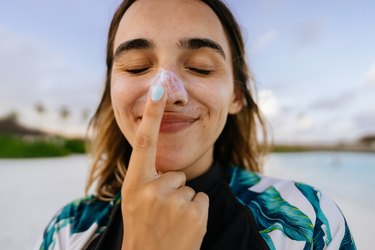
Any time your skin blisters from a sunburn, it means the skin has sustained UV damage. "This can increase a person's risk for skin cancer," Dr. Wood says. In fact, just one blistering sunburn as a child or teen more than doubles your risk for developing melanoma later in life, according to the Skin Cancer Foundation.
Preventing sunburns and blisters helps your skin avoid UV ray damage and can reduce your risk for skin cancer.
The best protection is limiting your sun exposure. You can do that by:
- Applying sunscreen regularly (even if you "never" burn)
- Limiting your time in the sun between 10 a.m. and 4 p.m., when the sun's rays are strongest, per the Cleveland Clinic
- Wearing sun-protective clothing like a wide-brimmed hat, and when possible, a long-sleeved shirt and long pants.
When to See a Doctor for Sunburn
Sunburn blisters don't always need medical attention. But serious sunburns might. According to the Mayo Clinic, you should let your doctor know if you have large blisters, especially on your face or genitals, or if the blisters are showing signs of infection, like swelling, streaks or pus.
Seek immediate medical attention for a fever over 103 degrees Fahrenheit, nausea or vomiting, confusion or symptoms of dehydration.
FAQ
1. Is It Bad If My Sunburn Blisters?
Blisters are a sign your skin has sustained UV-ray damage, Dr. Wood notes. That damage can increase your risk for skin cancer as well as premature aging.
That said, not all blistering sunburns require medical attention. Mild sunburns with small blisters can typically be managed at home, as long as the blisters aren't showing signs of infection.
2. What Are Sunburn Blisters Filled With?
Blisters are filled with a watery liquid called serum, which has leaked over from nearby tissues. The serum contains proteins and other compounds that may help wounded skin heal, according to a July 2021 Journal of Cutaneous and Aesthetic Surgery paper.
So even though it can be tempting to pop a sunburn blister, you're better off leaving it alone.
3. What Degree Sunburn Is a Blistering Sunburn?
Any sunburn can blister, even mild ones. But paying attention to other symptoms can help you determine what degree sunburn you might have. According to the Cleveland Clinic:
- First-degree sunburns cause redness, skin that feels hot or tight, pain or tenderness, blistering, swelling and peeling. You might also feel nauseous or fatigued, have a headache, or get a fever.
- Second-degree sunburns cause extreme redness, blisters or swelling over a large area, pain, wet-looking skin and white discoloration around the burn. They can also cause symptoms of heat illness like confusion, dizziness, exhaustion, headache, fever, fast breathing, nausea, muscle cramps or shivering.
- Third-degree sunburns are rare but require emergency medical treatment. They're marked by numbness and skin that looks leathery, white or dull. Third-degree sunburns also cause symptoms of heat illness, and in some cases, they can cause a person to go into shock. Call 911 right away if you have any of these symptoms.
- Cleveland Clinic: "Sunburn"
- Cleveland Clinic: "What You Should Know About Sun Poisoning Symptoms"
- Centers for Disease Control and Prevention: "Warning Signs and Symptoms of Heat-Related Illness"
- American Academy of Dermatology: "How to Treat Sunburn"
- Mayo Clinic: "Sunburn"
- Journal of Cutaneous and Aesthetic Surgery: "Role of Burn Blister Fluid in Wound Healing"
- Skin Cancer Foundation: "Sunburn"
Is this an emergency? If you are experiencing serious medical symptoms, please see the National Library of Medicine’s list of signs you need emergency medical attention or call 911.
